Using and Buying a Missal
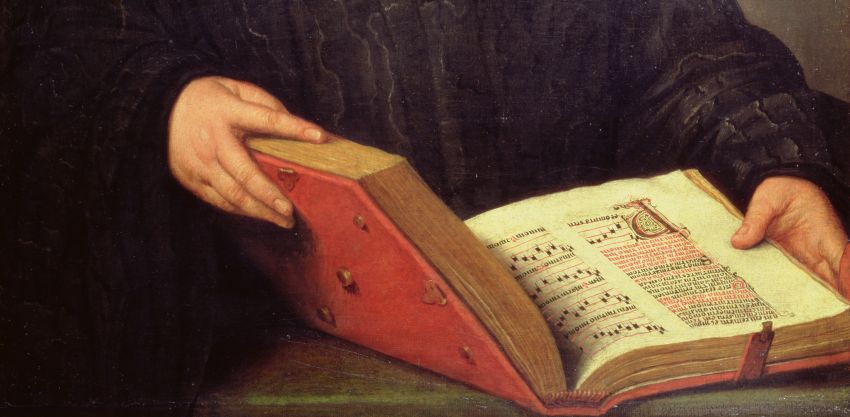
|
To understand
this content, you should first have an understanding of how the Church
liturgically treats time.
Read about The Liturgical Year, and then come
back to this page.
A missal is a book that contains the prayers and readings of the Mass.
It has two main sections:
- the
first contains "the Commons" -- those parts of the Mass that are
the
same from Mass, or the "Ordinary" of the Mass (the Prayers at the Foot
of the Altar; Kyrie; Gloria;
Creed; Offertory; Oblation; Lavabo; Preface; Sanctus; Canon of the
Mass; and Last Gospel)
- the
second contains "the Propers" -- those parts of the Mass that change
from Mass to Mass (the Introit; Collect; Commemoration, if applicable;
Epistle; Gospel; Secret; Communion and Postcommunion prayers).
The
Propers are further divided into two types: "The Proper of the Seasons"
(or
"Temporal Cycle") and "The Proper of the Saints" (or "Sanctoral
Cycle"). These two cycles are explained on the page about the
Liturgical Year linked to just above.
Some
Missals have all of a year's Masses, including daily Masses; others are
"Sunday Missals" and usually only contain the Proper of the Seasons. In
addition to the Commons and Propers, most Missals also include special
Masses (such as the Funeral Mass), hymns, prayers, and
the text used to make various
devotions, such as Benediction
of the Blessed Sacrament, the Stations of
the Cross, and so on.
The table of contents of a typical missal, this one "The New Roman
Missal" of 1938: |
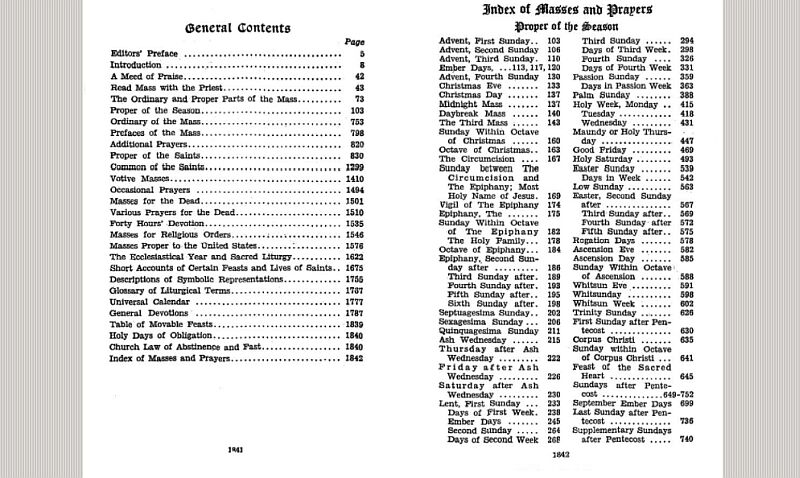
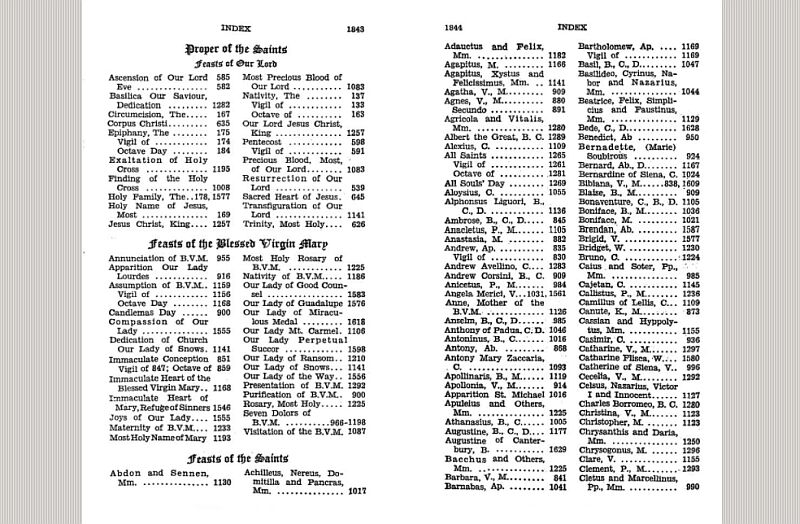
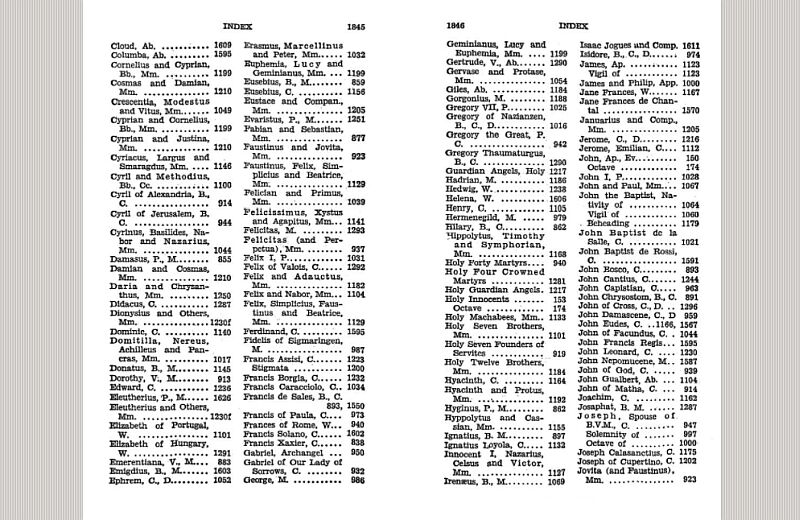
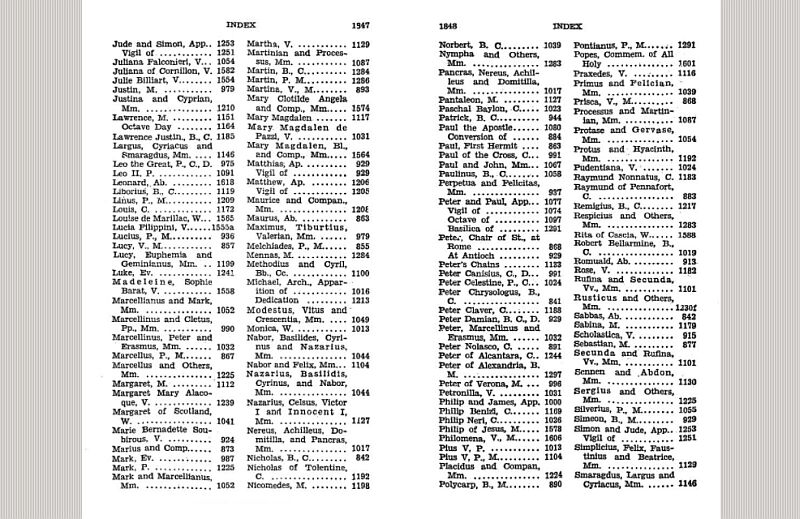
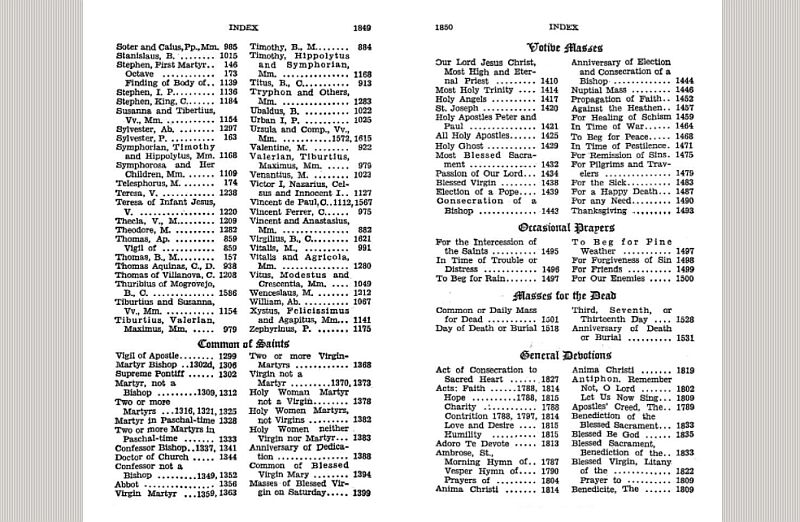
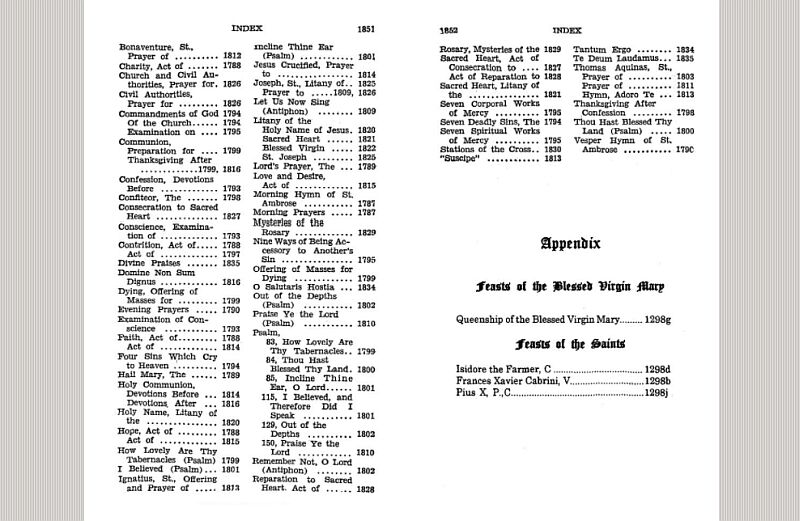
Most missals come with a bookmark made, typically, of five
ribbons of various colors, though they can have as few as three, or as
many as eight
(those sorts of bookmarks can be made at home or purchased separately
as
well). One of those ribbons should always mark the Ordinary of the
Mass, those parts of the Mass that never change. You always start on
that page when attending a Sunday Mass.
A second ribbon will mark the Propers particular to the Mass you are
attending. As an example, if you are using the above missal and are
attending Mass on the 7th Sunday before Lent, Septuagesima Sunday, you would use one
ribbon to mark page 753 (the Ordinary)
and another ribbon to mark page 202 (the Propers for Septuagesima
Sunday). You'd start on page 753,
with the Prayers
at the Foot of the Altar, and follow along until you come to the
Introit, at which point you'll flip to page 202. After the Introit,
you'll flip back to the Commons to get on with the Kyrie and Gloria.
Then you'll flip back to the Propers at the Collect. And on it goes
throughout the Mass. Per the table below, you start at the green dot,
then flip forward at the red arrows, and flip back again at the green
arrows:

|
Commons/Ordinary |
Prayers at the
Foot of the Altar |

|
Propers
|
Introit |

|
Commons/Ordinary
|
Kyrie
Gloria |
 |
Propers |
Collect
Commemoration, if applicable
Epistle
Gospel |
 |
Commons/Ordinary |
Creed
Offertory
Oblation
Lavabo |
 |
Propers |
Secret |
 |
Commons/Ordinary |
Preface
Sanctus
Canon of the Mass |
 |
Propers |
Communion
Poscommunion |
 |
Commons/Ordinary |
Last Gospel
|
After Mass has started, you'll typically have to make eight "flips." A
decent Missal will tell you when to go back and forth from the Commons
to the Propers; e.g., the missal above uses a
star to alert you when you need to switch to the Propers parts of the
Mass:

See the star?
A third bookmark might mark that part of the missal that contains any
"Common of Saints" that might be relevant to the day's Mass -- i.e.,
those parts of the Mass that some Saints' Masses have in common.
They're categorized by the type of Saint the Saint of the day is --
e.g., a Confessor (someone who's suffered for the Faith), a Martyr
(someone who gave his life for the Faith), a virgin, a Bishop, a Doctor
of the Church, etc.
The remaining bookmarks can be used to mark other pages that might be
relevant to the day's Mass -- for ex., the Litany
of Saints during the Easter Vigil
-- or to you personally (for ex., if you're going to Confession,
you might mark the page containing the Act of
Contrition).
Buying a
Missal
Which missal to buy depends a lot on whether one needs a daily Missal
or just a Sunday Missal, whether one wants the prayers in both English
and Latin, one's aesthetic preferences, etc. Of prime importance,
though, is knowing that traditional Catholic Masses as offered by the
FSSP, SSPX, ICK, etc., use the rite in place in 1962, so, ideally, you
want "a 1962 missal". Angelus
Press and Baronius
Press both offer new 1962 daily Missals which include both English
and Latin (both links are offsite and wil open in new browser windows).
Any missal newer than 1962 will not work (not even close), but older missals
can work just fine, and opting for such
can help you get a missal for a lot less money given
that such missals are easy to find used on E-bay, at Amazon.com, and,
more often than you'd think, at places that sell used books, such as
Salvation Army shops, etc. The St.
Andrew Daily Missal and the Father Lasance New Roman Missal are
highly recommended. Know, though, that there will be a few
differences with older
missals -- e.g., the lack of inclusion of St. Joseph's name
during the canon, and the fact that some feast days are no longer
celebrated liturgically on
the 1962 calendar -- but the only difference that really matters in
terms
of your ability to use an older missal concerns extremely unfortunate
changes made, between
1951 and 1956, to how Holy Week is honored.1 Nonetheless,
the savings to
be had by buying an older, used missal may be well worth it.
If you don't have a missal, all is not lost: most parishes and chapels
have booklets that contain the Ordinary, and print-outs that contain
the day's Propers. You'll likely find them in either the narthex or
in the
pews.
Footnotes:
1 The changes made -- between 1951
and 1955, under Pope Pius XII -- to the way Holy Week is
celebrated foreshadowed the sort of destruction made to the Mass after
Vatican II. The unnecessary and destructive changes include: Palm
Sunday changes that eliminate an overview of salvation history and
obfuscate the relationship between manna and the Eucharist; the
elimination of text that makes
very clear Christ's Kingship; elimination of prayer for the conversion
of Jewish
people (the prayers famously included the term "perfidious," meaning
faithless, to
describe those who reject the New Covenant); the elimination of prayers
that refer to the Sacrifice; the ending of the practice of placing a
tiny piece of the consecrated Host into the Chalice; changes that take
the focus away from the altar and Cross and put it on things like the
Paschal candle; rubrics that cause the priest to turn his back on the
altar repeatedly; the introduction of various novelties, such as
vernacular in certain places, the renewal of baptismal promises, etc.;
the suppression of the Judica Me
and prayers at the foot of the altar
on Holy Saturday; etc. Many priests have been granted permission to use
the pre-1955 form of Holy Week, praise God.
Site reader Fionnchu has a few things to
say about buying a missal. Read what he says here.
|
|
|
 Back to Being Catholic Back to Being Catholic
 Index Index
|

